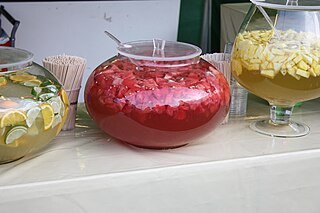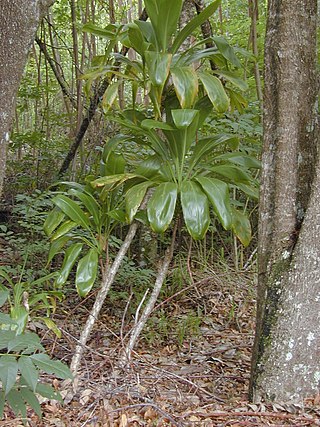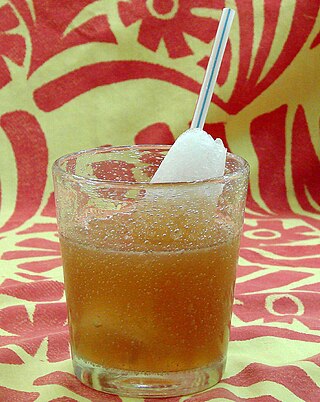
Mulled wine, also known as spiced wine, is an alcoholic drink usually made with red wine, along with various mulling spices and sometimes raisins, served hot or warm. It is a traditional drink during winter, especially around Christmas. It is usually served at Christmas markets in Europe, primarily in Germany, Austria, and eastern France. There are non-alcoholic versions of it. Vodka-spiked mulled wine can be found in Polish Christmas markets, where mulled wine is commonly used as a mixer.

The Zombie is a Tiki cocktail made of fruit juices, liqueurs, and various rums. It first appeared in late 1934, invented by Donn Beach at his Hollywood Don the Beachcomber restaurant. It was popularized on the East coast soon afterwards at the 1939 New York World's Fair.

The term punch refers to a wide assortment of drinks, both non-alcoholic and alcoholic, generally containing fruits or fruit juice. The drink was introduced from the Indian subcontinent to England by employees of the East India Company in the late 17th century. Punch is usually served at parties in large, wide bowls, known as punch bowls.

Eggnog, historically also known as a milk punch or an egg milk punch when alcoholic beverages are added, is a rich, chilled, sweetened, dairy-based beverage. It is traditionally made with milk, cream, sugar, egg yolks, and whipped egg whites. A distilled spirit such as brandy, rum, whisky or bourbon is often a key ingredient.

A hot toddy, also known as hot whiskey in Ireland, is typically a mixed drink made of liquor and water with honey, lemon, herbs and spices, and served hot. Recipes vary, and hot toddy is traditionally drunk before retiring for the night, in wet or cold weather or to relieve the symptoms of the cold and flu. In How to Drink, Victoria Moore describes the drink as "the vitamin C for health, the honey to soothe, the alcohol to numb."

Coquito meaning "Little Coconut" in Spanish is a traditional Christmas drink that originated in Puerto Rico. The coconut-based alcoholic beverage is similar to eggnog, and is sometimes referred to as Puerto Rican Eggnog. The mixed drink is made with Puerto Rican rum, coconut milk, cream of coconut, sweetened condensed milk, vanilla, nutmeg, clove, and cinnamon.

ʻŌkolehao is a Hawaiian alcoholic spirit whose main ingredient was the root of the ti plant. 'Ōkolehao's forerunner was a fermented ti root beverage or beer. When distillation techniques were introduced by English seamen in 1790, it was distilled into a highly alcoholic spirit.
A Scorpion Bowl is a communally shared alcoholic tiki drink served in a large ceramic bowl traditionally decorated with wahine or hula-girl island scenes and meant to be drunk through long straws. Bowl shapes and decorations can vary considerably. Starting off as a single-serve drink known as the Scorpion cocktail, its immense popularity as a bowl drink in tiki culture is attributed to Trader Vic.

A flip is a class of mixed drinks. According to the Oxford English Dictionary, the term was first used in 1695 to describe a mixture of beer, rum, and sugar, heated with a red-hot iron. The iron caused the drink to froth, and this frothing engendered the name. Over time, eggs were added and the proportion of sugar increased, the beer was eliminated, and the drink ceased to be served hot.

There are many cocktails made with cachaça, the national spirit of Brazil. The caipirinha is by far the most popular and internationally well-known, but bartenders have developed other mixed drinks using the spirit.

The Navy Grog was a popular rum-based drink served for many years at the Polynesian-themed Don the Beachcomber restaurants; it is still served in many so-called tiki restaurants and bars. First created by Donn Beach, who almost single-handedly originated the tiki cultural fad of the 1940s and 1950s, it was one of dozens of rum concoctions that he, and later Trader Vic and numerous other imitators, sold in exotic tropical settings. Not quite as potent as the Beachcomber's more famous Zombie, it was, nevertheless, shown on the menu as being limited to two, or sometimes three, to a customer. Reportedly, Phil Spector consumed at least two Trader Vic’s Navy Grogs at the Beverly Hilton restaurant, without eating any food, the night he later killed actress Lana Clarkson.

Mulling spices are a spice mixture used in drink recipes. The spices are usually added to hot apple cider, mulled wine, glögg, wassail, hippocras, and other drinks during autumn or winter. A "mulled" drink is a beverage that has been prepared with these spices. Mulling spices may also be added to the brewing process to make spiced beer.

Trader Sam's Enchanted Tiki Bar is a tiki bar located at the Disneyland Hotel in the Disneyland Resort of Anaheim, California, that opened in May 2011. Named one of the top five tiki bars in Los Angeles by LA Weekly, Trader Sam's is one of many tiki bars gaining popularity throughout the United States, and even the world, in what some call tiki's "third wave". It is not to be confused with the San Francisco, California tiki bar Trad'r Sam founded in 1937.

The doctor cocktail is a pre-prohibition era cocktail that traces in drink guides to as far back as 1917, when it appeared in Hugo R. Ensslin's Recipes for Mixed Drinks. As originally described the cocktail called simply for Swedish Punsch mixed with lime juice.

The suffering bastard is the name for two different mixed drinks, one being more of a standard cocktail associated with World War II and the other being more of an exotic drink associated with Tiki bars. As is the case with many cocktails, there are multiple recipe variations and historical origins have been argued and changed over time. Two of the earliest recipe versions have very different ingredients. One from bartender Joe Scialom (1942) calls for brandy and gin, while another from Tiki pioneer Victor J. Bergeron primarily uses rum along with "secret ingredients" and is known for being garnished with a cucumber.
The test pilot cocktail is a vintage tiki drink invented by Donn Beach. Beach was known for changing his recipes over time, and multiple versions of the test pilot attributed to both him and others make the cocktail one of his more frequently imitated and varied tiki drinks. Test pilot recipes call for multiple rums and typically include the use of falernum syrup and lime juice. The more popular also include Pernod (pastis/absinthe) and bitters.
Mr. Bali Hai is a tiki drink served in a special mug at the Bali Hai restaurant on Shelter Island in San Diego, California. The drink has had different recipes over the years, but a prominent version from the 1970s calls for 1 1/2 oz of dark Jamaican rum, 1 oz light Puerto Rican rum, 3/4 oz coffee flavored brandy, 1 1/2 oz unsweetened pineapple juice, 1 oz lemon juice, and 1/2 oz of sugar syrup. The mug has the same name as the drink, Mr. Bali Hai, and comes in the shape of a headhunter's head with a removable lid.
The Fog Cutter is a vintage tiki cocktail frequently attributed to being invented by Victor Bergeron that calls for a mixture of several liquors, the juice of lemon and oranges, orgeat syrup, and cream sherry. It is high in alcoholic content and has been called the "Long Island Iced Tea of exotic drinks." It has historically been served in special Fog Cutter ceramic mugs.

Jeff "Beachbum" Berry is an American restaurant owner, author, and historian of tiki culture, particularly the drinks associated with the tiki theme. In addition to researching and reconstructing lost recipes, he has invented and published his own cocktail recipes.

















